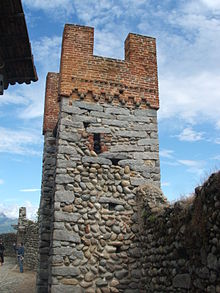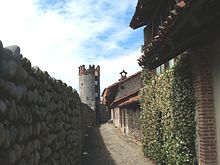| Candelo | ||
 | ||
| State | Italy | |
|---|---|---|
| Region | Piedmont | |
| Territory | Biellese | |
| Altitude | 340 m a.s.l. | |
| Surface | 15.12 km² | |
| Inhabitants | 8.058 (2010 census) | |
| Name inhabitants | Candelesi | |
| Prefix tel | 39 015 | |
| POSTAL CODE | 13878 | |
| Time zone | UTC 1 | |
| Patron | San Lorenzo (10 August) | |
Position
| ||
| Tourism site | ||
| Institutional website | ||
Candelo is a city of Piedmont.
To know
The town of Candelo is one of the most beautiful villages in Italy, a title that has been recognized for its Recipe and was awarded the orange flag by the Italian Touring Club.
Geographical notes
At the foot of the Biella mountains, it is 5 km from Biella, 26 from Santhià, 31 from Ivrea, 37 from Vercelli, 40 from Novara.
Background

Documented since 988, when Otto III gave it to Manfredo and immediately afterwards to the Church of Vercelli, Candelo sees between the end of the XIII and the beginning of the XIV century the construction, by its inhabitants, of the Ricetto; in 1360 there are documented 157 houses, which then rose to the number of 200 that are counted today.
The center is given to the Savoy in 1374 with a spontaneous act of dedication, entering under the jurisdiction of Santhià. Amedeo VII of Savoy then gave it to Gerardo Fontana, a family who ceded it in 1476 to Sebastiano Ferrero; by line of succession it will then become the prerogative of the Ferrero-Fieschi family. In the sixteenth century Candelo is involved in the struggles between France and Spain, undergoing more than one onslaught of troops; on this occasion the Ricetto suffered a lot of damage, repaired in 1561.
The fiefdom of Candelo becomes a County in 1577, whose first count is Besso Ferrero Fieschi; the last was Carlo Sebastiano Ferrero Fieschi, who in 1785 lost possession with the abolition of feudal rights.
How to orient yourself

Neighborhoods
The municipal territory of Candelo also includes the town of San Giacomo.
How to get
By car
 Carisio motorway exit on the A4 motorway Serenissima
Carisio motorway exit on the A4 motorway Serenissima It is crossed by the former state road, now Provincial Road 307 Candelo - Castellengo.
It is crossed by the former state road, now Provincial Road 307 Candelo - Castellengo.
On the train
How to get around
What see




- Recipe. The ricetto it is generally a fortified structure protected within a village where the goods (fodder, wines, etc.) of the local lord or the population were accumulated and where, occasionally, the population itself withdrew in case of attacks from the outside. The Ricetto di Candelo it is one of the best preserved examples of this type of medieval structure present in various locations in Piedmont and in some areas of central Europe. Like other shelters, that of Candelo never appears to have been used as a permanent home. By virtue of its position, it offers a panoramic view over the entire Biella Pre-Alps area, to the north, and towards the Baraggione (Oriented Natural Reserve of the Baragge) to the south.
- The peasant matrix of the Candelo complex - and the direct testimony of the fact that in ancient times it was used as a collective deposit for agricultural products, in particular for wine (given the particular vocation of the area), almost a sort of ante litteram social cellar - is given by the presence, in one of the cellars, of a huge press for crushing the grapes. The dimensions of this press clearly suggest that it is a tool used by the whole community to meet needs that are obviously long over time.
- The shelter is made up of about two hundred named buildings cells which occupy an area of about 13,000 square meters with a pentagonal shape and a perimeter of about 470 meters. It measures approximately 110 meters wide by 120 meters long. The complex is crossed by streets, clearly defined rue: these are five rue in an east-west direction, intersected by two orthogonals. The starting date of its construction cannot be determined with accuracy, even if the first known mention of Candelo, in its ancient name Canderium, dates back to the year 988, in a document in which Otto III confirms its possession to the feudal lord Manfredo, except then, the following year, to confer the village to the fiefdom belonging to the Vercelli Church. Those who have studied its history tend to place its construction, on land granted by the Vialardi di Villanova, between the end of the thirteenth and the beginning of the fourteenth century, while it is certain that it existed in the year 1374, when the community of Candelo made an act of spontaneous dedication to the House of Savoy.
- The structure is almost entirely surrounded by walls, with cylindrical towers at the corners, with the exception of the southern side, where the town hall was built in 1819, in a decidedly neoclassical style that contrasts with all the oldest part. The only possibility of access was given by a massive parallelepiped-shaped tower made of squared boulders at the bottom and brick at the top, with two openings to the outside, a larger one for wagons and a smaller one for pedestrians. closed by as many drawbridges.
- At the beginning of the sixteenth century, by modifying and elevating the pre-existing cells, Sebastiano Ferrero, feudal lord of the place since 1496, under the investiture of Duke Filippo II Senzaterra, had his house built, in fact a fortified tower, which is the highest building in the ricetto and is commonly known as Prince's house.
- The approximately two hundred residential cells are almost all belonging to private individuals and associations based in Candelo; i report in particular:
- the Hall of ceremonies, home to the main exhibitions
- the Historical Archive
- the cells of the museum-system of the Candelese territory including the cellars ofEcomuseum of viticulture (which is part of the wine districts) and those intended for the display of collections and documents that report historical and geographical data concerning the territory
- In addition to various art shops there are the following structures:
- the Documentation Center of Recipes in Europe
- the Small Museum of Kitchen and Pastry Things, a collection of hundreds of objects, machinery and equipment of popular or professional use in the field of cooking and pastry. It is also a study center on local and Piedmontese gastronomic culture with an important library and thematic newspaper library available to scholars or enthusiasts. Visits by appointment.
- the Museum of the natural and historical landscape of viticulture
- Church of Santa Maria Maggiore, via Roma. It is a church dating back to the 12th century. It has undergone repeated changes and extensions until the 18th century. Precious are the internal finishes in wood; the fifteenth-century capitals are beautiful; it preserves works of art from the 17th century, frescoes from the end of the 15th century and a pulpit from the mid-17th century. The Romanesque façade is built with stream stones arranged in a fishbone pattern.
- Church of San Lorenzo, Via San Lorenzo. Its original construction dates back to a period prior to the year 1000. It was entirely rebuilt in Baroque style in the second half of the 17th century. Works of art and precious wood finishes are preserved inside.
- Church of San Pietro.
Environment
- Oriented Natural Reserve of the Baragge. The territory of the reserve is mainly flat or hilly, ideal for foot excursions (trekking) or on horseback or even by bicycle.
Events and parties
What to do
- Oriented Natural Reserve of the Baragge. The territory of the reserve is particularly suitable for
- running excursions
- trails on horseback
- cycling.
Shopping
In Candelo a particular salami under fat is produced called salam ´d the classroom. Another typical salami is the candelese scoop which is obtained from the degreased pork shoulder blade, processed manually according to ancient rules of the peasant tradition; it is produced in limited quantities.
Among the desserts are typical i crunchy Ciavarìn.
How to have fun
Where to eat
Average prices
- Receptum, Castle Square 31, ☎ 39 015 2536066.
- Trattoria Doria, Via Giuseppe Mazzini, 15, ☎ 39 015 2538469.
- The Open Court, Via Cerventi, 1, ☎ 39 340 4907430.
- Pizza Yes, Via 4 Novembre, 44, ☎ 39 015253 8970.
- Mirage Pizzeria, Via Marconi, 86, ☎ 39 015 2538542.
- Trattoria La Cantina Antica, Via San Grato, 34, ☎ 39 015 2536882.
- Locanda La Greppia in Candelo, Piazza San Lorenzo 3 (Ricetto di Candelo), ☎ 393333700425.
Where stay
Average prices
- Mimosa, Via Pietro Micca, 36 (Ricetto di Candelo), ☎ 39 015 2538264. Bed & Breakfast.
- Home Sweet Home, Via Sandigliano, 89 (Ricetto di Candelo), ☎ 39 015 2538665. Bed & Breakfast.
- The Jade Garden, Via Sandigliano, 163, ☎ 39 340 5247190. B&B open from March to October.
- The courtyard, Via del Carmine, 5 (Ricetto di Candelo), ☎ 39 015 2536021. Bed & Breakfast.
Safety
- Carabinieri, Corso Libertà, 89, ☎ 39 015 2536037.
Pharmacies
- Ricetto Pharmacy, Via Sandigliano, 112 / B, ☎ 39 015 2530785.
- Robiolio Pharmacy, Liberty Course, 100, ☎ 39 015 2536073.
Parapharmacies
- Foletto parapharmacy, Via Iside Viana, 29, ☎ 39 015 2499005.
- Parapharmacy Piazza Castello, Piazza Castello 37, ☎ 39 015 2539460.
How to keep in touch
Post office
- Italian post, Via Iside Viana 50, ☎ 39 015 2537155, fax: 39 015 2538063.

